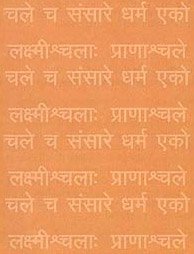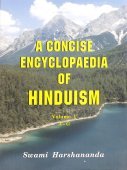Pitriloka, Pitri-loka, Pitṛloka: 13 definitions
Introduction:
Pitriloka means something in Hinduism, Sanskrit, Marathi. If you want to know the exact meaning, history, etymology or English translation of this term then check out the descriptions on this page. Add your comment or reference to a book if you want to contribute to this summary article.
The Sanskrit term Pitṛloka can be transliterated into English as Pitrloka or Pitriloka, using the IAST transliteration scheme (?).
In Hinduism
Purana and Itihasa (epic history)
Source: Cologne Digital Sanskrit Dictionaries: The Purana IndexPitṛloka (पितृलोक).—Reached by the southern part of Aryaman;1 Āgnīdhra wanted to attain this;2 a bath in the Manoharam tīrtha of the Narmadā leads one to.

The Purana (पुराण, purāṇas) refers to Sanskrit literature preserving ancient India’s vast cultural history, including historical legends, religious ceremonies, various arts and sciences. The eighteen mahapuranas total over 400,000 shlokas (metrical couplets) and date to at least several centuries BCE.
Samkhya (school of philosophy)
Source: Wisdom Library: Sāṃkhya philosophyPitṛloka (पितृलोक) refers to the world of Paitra and represents a division of the divine creation (daivasarga or ūrdhvasarga) according to the Sāṃkhyakārikā. The daivasarga is one of the three types of elemental creation, also known as bhautikasarga.
The Sāṃkhyakārikā by Iśvarakṛṣṇa is the earliest extant text of the Sāṃkhya school of philosophy and dates from the 4th century CE. It contains 72 Sanskrit verses and contents include epistemology and the theory of causation.

Samkhya (सांख्य, Sāṃkhya) is a dualistic school of Hindu philosophy (astika) and is closeley related to the Yoga school. Samkhya philosophy accepts three pramanas (‘proofs’) only as valid means of gaining knowledge. Another important concept is their theory of evolution, revolving around prakriti (matter) and purusha (consciousness).
General definition (in Hinduism)
Source: Wisdom Library: HinduismPitṛloka (पितृलोक) is a Sanskrit word referring to the realm of the ancestors.
Source: Hinduism Vocubalary: HinduismAccording to the Upaniṣads (see esp. Bṛhadāraṇyaka 6.2.16; Chāndogya 5.10.3), the intermediate and impermanent after-death world (loka), adjacent to the moon, reached by those who have led proper lives as sacrificers and gift-givers, but who will eventually be reborn.
Languages of India and abroad
Marathi-English dictionary
Source: DDSA: The Molesworth Marathi and English Dictionarypitṛlōka (पितृलोक).—m (S) The region or heaven (according to some, the orbit of the moon) inhabited by the manes or deified progenitors of mankind.
Marathi is an Indo-European language having over 70 million native speakers people in (predominantly) Maharashtra India. Marathi, like many other Indo-Aryan languages, evolved from early forms of Prakrit, which itself is a subset of Sanskrit, one of the most ancient languages of the world.
Sanskrit dictionary
Source: DDSA: The practical Sanskrit-English dictionaryPitṛloka (पितृलोक).—the world of the Manes.
Derivable forms: pitṛlokaḥ (पितृलोकः).
Pitṛloka is a Sanskrit compound consisting of the terms pitṛ and loka (लोक).
Source: Cologne Digital Sanskrit Dictionaries: Shabda-Sagara Sanskrit-English DictionaryPitṛloka (पितृलोक).—m.
(-kaḥ) The world or sphere of the manes: it is variously situated, but principally in I huva region or midheaven. E. pitṛ, and loka world.
Source: Cologne Digital Sanskrit Dictionaries: Cappeller Sanskrit-English DictionaryPitṛloka (पितृलोक).—[masculine] the father’s house; the world or abode of the Manes.
Source: Cologne Digital Sanskrit Dictionaries: Monier-Williams Sanskrit-English Dictionary1) Pitṛloka (पितृलोक):—[=pitṛ-loka] [from pitṛ] m. a f°’s house, [Atharva-veda xiv, 2, 52]
2) [v.s. ...] the world or sphere of the P°s [Atharva-veda; Śatapatha-brāhmaṇa; Mahābhārata] etc. (cf. [Religious Thought and Life in India 28]).
Source: Cologne Digital Sanskrit Dictionaries: Yates Sanskrit-English DictionaryPitṛloka (पितृलोक):—[pitṛ-loka] (kaḥ) 1. m. Hades.
[Sanskrit to German]
Sanskrit, also spelled संस्कृतम् (saṃskṛtam), is an ancient language of India commonly seen as the grandmother of the Indo-European language family (even English!). Closely allied with Prakrit and Pali, Sanskrit is more exhaustive in both grammar and terms and has the most extensive collection of literature in the world, greatly surpassing its sister-languages Greek and Latin.
Kannada-English dictionary
Source: Alar: Kannada-English corpusPitṛlōka (ಪಿತೃಲೋಕ):—[noun] the region where manes are supposed to live.
Kannada is a Dravidian language (as opposed to the Indo-European language family) mainly spoken in the southwestern region of India.
See also (Relevant definitions)
Full-text: Aryaman, Arjama, Dakshinayanamarga, Adhishthanadeha, Adhishthanasharira, Loka, Praushthapadyashtaka, Dhumadimarga, Pitritirtha, Ativa, Bhautikasarga, Ashtaka, Alakananda, Prajapatya, Shraddha, Pingala, Devasharma.
Relevant text
Search found 23 books and stories containing Pitriloka, Pitṛ-loka, Pitr-loka, Pitṛ-lōka, Pitri-loka, Pitṛloka, Pitrloka, Pitṛlōka; (plurals include: Pitrilokas, lokas, lōkas, Pitṛlokas, Pitrlokas, Pitṛlōkas). You can also click to the full overview containing English textual excerpts. Below are direct links for the most relevant articles:
Significance of the Moon in Ancient Civilizations (by Radhakrishnan. P)
8. The Moon and Pitriloka < [Chapter 10 - Analysis of the Data]
Mahabharata (English) (by Kisari Mohan Ganguli)
Section CIX < [Bhagavat-Yana Parva]
Puranic encyclopaedia (by Vettam Mani)
The Skanda Purana (by G. V. Tagare)
Chapter 219 - The Greatness of Koṭi Tīrtha < [Section 3 - Revā-khaṇḍa]
Chapter 224 - The Greatness of Koṭīśvara Tīrtha < [Section 3 - Revā-khaṇḍa]
Chapter 158 - The Greatness of Saṅgameśvara (saṅgama-īśvara-tīrtha) < [Section 3 - Revā-khaṇḍa]
The Devi Bhagavata Purana (by Swami Vijñanananda)
Related products
